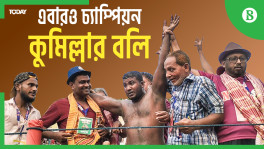Does growth mean everything?
To achieve the goals and keep the economy growing, we will have to go along the right path. We must make doing business easier to stay competitive

Bangladesh -- An indomitable nation
Bangladesh is now a role model of development due to its unprecedented success almost in all socioeconomic indicators, including reduction of poverty, gender inequality, and success in achieving Millennium Development Goals (MDG). Now, the country's vision is to be a middle-income country by 2021 and a developed country by 2041.
Bangladesh's economy is standing on a strong footing to fulfill all the criteria to be a middle income country. From $676 in 2009, per capita income has reached to $1909 in 2019 and population under poverty line dropped to 21.8 percent from 40 percent. Inward remittance, export, foreign direct investment and foreign exchange reserves grew impressively, giving Bangladesh's economy a solid base. Electricity generation once was a major hindrance to economic growth. Improvement in this sector has been even more impressive -- from less than 5,000MW to over 22,500MW, which is 4.5 times higher in 10 years. Crop production has grown significantly, cutting food import bills. The economy has posted a robust and steady growth -- from 5.14 percent to 8.2 percent.
Our economy has been on the threshold of completing its first phase of transformation, from agriculture to industry-led one. As a result, the share of agriculture has dropped from a third of GDP to 13.6 percent in 2018-19 fiscal year, while industry's contribution has more than doubled to 35.14 percent in 28 years. Service sector held on to its share in GDP, accounting for roughly half of the country's economy over the period that saw industry taking over agriculture, indicating the nation's rapid journey towards industrialization.
Bangladesh had a robust growth in last 10 years. But does it mean everything? If so, why equality in income and distribution of economic growth are not seen across Bangladesh? It is time for us, the business leaders, to take responsibilities to support the government to formulate policies to diversify and decentralise our economic growth and make it more inclusive.
While having a steady growth, we have some challenges too. We have a higher growth, which is not generating much employment. While unemployment continues to remain a headache, our industries are facing a shortage of skilled manpower and professionals. Inequality of income prevails and fruits of the growth are not proportionately distributed across the country. Despite visible progress in developing transport infrastructures, we are still lacking in industrial infrastructure. It is holding back further expansion.
In 2018, a total of 6.44 crore people were employed. More than a half (3.73 crore) of them earned their livelihood from unorganized sector. About 2.2 million people are entering the job market every year, but only 1.6 million were employed in 2018. Employment in agriculture saw a decline in last 10 years, though it still remains the highest employer, followed by service sector. Employment in industry sector is still the lowest, despite some increase in last 10 years.
Professionals make up only a little -- over six percent -- while unskilled workforce accounts for more than 40 percent of total jobs of 25-54 years group. The government has announced a plan to create 15 million jobs by 2023.
Some threats are looming large. While graduation to middle income country will boost our image globally, it will take away some major privileges, making our trade difficult with the rest of the world. Being a least developed country, we have been enjoying duty-free market access for 75 percent of our exports, which will be over once we step out of the LDC territory in 2024.
For European Union, the facilities will however continue for three more years. By then, Vietnam looks set to emerge as a key contender in the EU, as the country's free trade agreement will benefit about 11 percent of its export with duty-free access right from the first year of implementation of the deal.
Bangladesh needs to diversify its export products and markets with upgradation in standards to stay afloat in global market.
The 4th Industrial Revolution (4IR) is feared to wipe out 800 million jobs worldwide by 2030, and Bangladesh may face 5.7 million job cuts. Bangladesh needs to progress in Global Innovation Index, which now ranks us 116th out of 129 countries.
Bangladesh has set a number of near-term and mid-term visions: middle income country by 2021, creating 2.1 million additional jobs by 2024, raising power generation capacity to 40,000MW in 2030 and increasing private investment to 40 percent of GDP.
We have some opportunities which may help us achieve those goals. We can identify six sectors: light engineering, agriculture, leather goods, halal goods, blue economy and IT sectors.

Bangladesh has tremendous opportunities to keep growing. Micro and small industries can certainly play a vital role to build our nation. We should follow the models of Japan and China, where small and medium enterprises (SMEs) contribute 75-80 percent of their GDP and jobs. But in Bangladesh, SMEs share 52-55 percent of GDP and 45-48 percent of jobs. If we follow those models successfully, Bangladesh will certainly be able to reach the targets set by the government.
To achieve the goals and keep the economy growing, we will have to go along the right path. We must make doing business easier to stay competitive, create employment, increase productivity and wage, move from informal to formal sectors, go for geographic decentralisation of economic activities and reduce income inequalities. To sustain our growth, we have to take up proper strategies to take advantage of the 4th Industrial Revolution and technological upgradation through advanced data analytics, artificial intelligence and other modern technologies to add more value and save cost, time and natural resources.
In our country, 35 million people live in urban areas and if the present trend of migration to cities continues, the number would reach to 80 million by 2030. Of the total urban population, nearly 32 percent live in Dhaka. The capital city contributes 37.7 percent to GDP compared with 19.3 percent from port city Chattogram. These two cities account for 80 percent of the country's total manufacturing output.
Are resources enough to chase big targets?
The government set a number of near- and mid-term targets to be achieved by the year 2041. Prominent of those are: becoming a middle income country with 8-10 percent growth with private investment reaching 31.5 percent of GDP by 2021, reducing poverty to zero and creating 2.1 million jobs by 2024, achieving Sustainable Development Goals (SDGs), raising power generation capacity to 40,000MW by 2030, and becoming a developed country with per capita income of $12,000 by 2041.
A huge working population below the age of 40 years is one of the major resources available with us to chase those targets. Three out of every four people are below 40 years, while nearly a third of our total population are in 15-30 years age group. The number of educated and skilled youths (18-35 years) will be 60 million in 2030. Our working people are quick learner and easily trainable to meet requirements of industries both at home and abroad. Our land is fertile giving us a natural strength. Accompanied with rapid farm mechanization, it will boost our farm output and confidence about food security. The planned 100 economic zones, once developed, will become the future hubs of industrial activities.
There are six areas, which hold vast potentials. These are light engineering, agriculture, leather goods, halal goods, blue economy and IT sector. Apart from nursing these sectors, we need to find the right path for an inclusive and job-creating growth through ensuring stability, transformation and sustainability of our economy.
Agriculture, remittance and apparel are the three pillars of stability of our economy while light engineering and agro-processing industries are the driving forces that can transform our economy towards an industry-led one.
Light engineering has a global market of $7 trillion while Bangladesh's exports stand only at $319 million. Of the $8.2 billion domestic market of light engineering products, our industries cater $3.1 billion. About 40,000 units in this sector employ one million people. Though these units have progressed in making farm and industrial machinery and parts which were previously imported, they are still lagging in making spare parts for automobiles. Almost all spare parts of automobiles and motorcycles are imported.

However, light engineering sector has been on the government's priority list and already declared as a thrust sector with cash incentives and VAT waiver.
Another potential sector for our much-needed transformation is agro-processing. The global market size of agro-processing products is $1.6 trillion, while Bangladesh's share is less than $1 billion, compared to $40b of Thailand and 435b of Vietnam. Our local market of processed agro-products is between Tk 20,000 crore and Tk30,000 crore.
Last of all, we need to sustain our economic growth. Last three centuries brought three revolutions in industries: hydraulic engine, electricity and digital electronic. This century is for the 4th Industrial Revolution. We are to move forward with Artificial Intelligence, robot, machine learning, genetic engineering, nanotechnology, etc. Automation is likely to erode many conventional professions. Mandatory inclusion of quantitative literacy and computing skill and basic course in conventional education is a necessity of the day. The purpose of education in the 21st century would be to distinguish oneself from a machine. Workforce must develop skills that cannot be replicated by robots. Those include fostering creativity, problem solving ability, leadership and people management skill, critical thinking ability and adopting training. There would be adverse impacts on the jobs of women and low education groups. So our policies need to focus on training, education, potential impact assessment, appropriate data and quality research to offset those impact and prepare our workforce for the future odds.
Other challenges cannot be overlooked too. Although the private sector is the main driver of economy, there is a lack of entrepreneurs as the second generation is not coming up the way they were expected. Customs policies are not yet friendly to businesses while needs for low cost fund and venture capital are still far from being met.
We believe, through consultation with all stakeholders, Insha-Allah we will be able to formulate a better policy to develop more entrepreneurs and create more jobs to make our economic growth inclusive and sustainable.


 Keep updated, follow The Business Standard's Google news channel
Keep updated, follow The Business Standard's Google news channel














